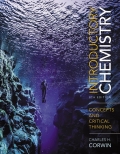
Concept explainers
(a)
Interpretation:
The term that describes the conversion of gas to liquid is to be stated.
Concept introduction:
Any substance in the universe which occupies volume and possesses mass is known as matter. Matter can be classified physically as well as chemically.
The physical classification of matter is as follows:
• Solids
• Liquids
• Gases
The solid
(b)
Interpretation:
The term that describes the conversion of liquid to solid is to be stated.
Concept introduction:
Any substance in the universe which occupies volume and possesses mass is known as matter. Matter can be classified physically as well as chemically.
The physical classification of matter is as follows:
• Solids
• Liquids
• Gases
The solid state of matter consists of a fixed shape and fixed volume. The liquid state of matter consists of fixed volume but does not possess a fixed shape. This state of matter takes the shape of the vessel in which it is stored. The gaseous state of matter possesses neither a fixed volume nor a fixed shape.
Want to see the full answer?
Check out a sample textbook solution
Chapter 3 Solutions
EBK INTRODUCTORY CHEMISTRY
- The processes of melting and evaporation involve changes in the of a substance.arrow_forwardName of the liquid having solid , gas , liquid at same temperature.arrow_forwardA substance has a definite shape and definite volume. What is the state of the substance?(a) solid (b) liquid (c) gasarrow_forward
- Engineering materials are materials utilized in the development of new technologies. (A) True (B) Falsearrow_forwardState whether each of the following is a physical or a chemical property. (a) Sugar ferments to ethanol. (b) Ethanol dissolves in gasoline. (c) Ethylene glycol freezes at -12 °C. (d) Ethanol burns with a light blue flame.arrow_forwardClassify each of the following as an element, compound, or mixture. (a) iron metal (b) oxygen gas (c) iron oxide (d) iron orearrow_forward
- Which of the following is a liquid nonmetal under normal conditions: sodium, mercury, -bromine, or sulfur?arrow_forwardState whether each of the following properties is more typical of a metal or a nonmetal. (a) dull powder (b) colorless gas (c) high density (d)reacts with metalsarrow_forwardState the term that applies to each of the following changes of physical state: (a) Snow changes from a solid to a liquid. (b)Gasoline changes from a liquid to a gas. (c) Dry ice changes from a solid to a gas.arrow_forward
- Provide the formula for each of the following binary ionic compounds. (a) stannic nitrite (b) ferrous acetatearrow_forwardWhich of the following states of matter assume the volume & shape of the container? (a) solid (b) liquid (c) gas (d) all of the above (e) none of the abovearrow_forwardExplain the following changes in states of matter. Write one example for each. (A) Condensation (B) Sublimationarrow_forward
 Introductory Chemistry: An Active Learning Approa...ChemistryISBN:9781305079250Author:Mark S. Cracolice, Ed PetersPublisher:Cengage Learning
Introductory Chemistry: An Active Learning Approa...ChemistryISBN:9781305079250Author:Mark S. Cracolice, Ed PetersPublisher:Cengage Learning Introductory Chemistry: A FoundationChemistryISBN:9781337399425Author:Steven S. Zumdahl, Donald J. DeCostePublisher:Cengage Learning
Introductory Chemistry: A FoundationChemistryISBN:9781337399425Author:Steven S. Zumdahl, Donald J. DeCostePublisher:Cengage Learning

